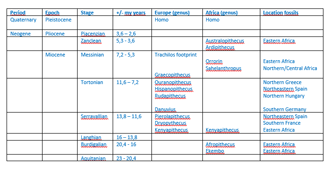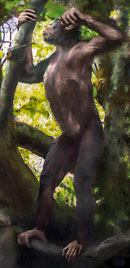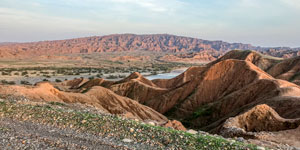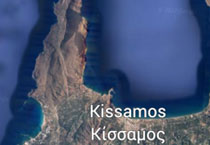|
||||||||||||
|
Page 1/5
|
Looking for the northern ape-man webpage 4/5
Text, photography: Annemieke van Roekel
Role of Europe in early human evolution 
Drought migration According to Böhme, the Trachilos site is so important because so far no later fossils of possible hominin-ancestors have been found in Eurasia (Table 1). Hominini includes the living genera Homo and Pan (chimpanzees and bonobos) and a few more extinct primitive hominids. "That may be because we haven’t found the fossils yet, but in time Trachilos coincides with the Messinian Salinity Crisis (MSC)." According to Böhme, the MSC had a major impact on the climate in the Northern Hemisphere (esp. the mid-latitudes, between 23 and 65 degrees North). This would have caused desertification on a large scale. Our distant ancestors would have migrated south to tropical regions during the MSC via the eastern Mediterranean, according to Böhme's hypothesis. 
Böhme sees this possible migration of great apes at the time of the late Miocene in a broader context. Many African savannah animals have their origin in areas in the higher latitudes, in Eurasia, such as the white rhinoceros and the giraffe, which has long been known to have European roots. In a recent study (Böhme et al., 2021), she describes periods of extreme drought in the northern Arabian Peninsula at various time intervals during the late Miocene and Pliocene, initiating migration waves of large mammals. Fig. 13. Böhme found evidence through sedimentary analysis of four short periods of desertification in the Middle East (Mesopotamia), each lasting several tens of thousands of years, with maxima between 9 and 6 my years ago. An exceptionally long period with a desert climate in the Middle East occurred between 5.6 and 2.3 million years ago, at the same time as the drying out of the Mediterranean, also referred to as the Neogen Arabian Desert Climax (NADX). During the NADX, many large mammal species would have migrated to Africa via the Levant, after which endemic diversification occurred. Thereafter, migration occurred in both directions. The Trachilos hominin was part of these waves of migration to Africa, according to Böhme. 
Page 1/5 Page 2/5 Page 3/5 Page 4/5 (this page) Page 5/5 Last update: April 16, 2022 |
|||||||||||
